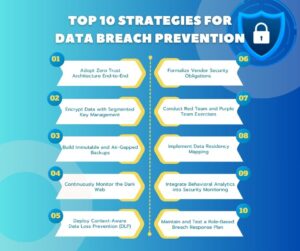
When your organization holds sensitive information, be it client’s legal documents, financial records, medical data, or intellectual property, you’re safeguarding assets that can directly impact revenue, compliance, and trust.
A breach isn’t just about lost data. It can trigger regulatory penalties, contractual disputes, reputational harm, and, in many sectors, litigation.
If you already have baseline measures in place (password policies, antivirus, basic backups), the question becomes: How to protect your data against the more sophisticated threats? The answer lies in strategies that combine technology, process, and people-focused controls, not just one layer of defense.
Here are 10 advanced, real-world strategies for data breach prevention that apply across industries, from law to healthcare, finance to manufacturing.
How to Protect Your Data from a Breach: Top 10 strategies

1. Adopt Zero Trust Architecture End-to-End
Zero Trust means no one, inside or outside, is trusted by default. Access is verified continuously based on user identity, device health, location, and behavior.
In practice, this means:
- Micro-segmentation of your network so finance data is walled off from HR systems, and client project files are isolated from operational tools.
- Adaptive authentication that increases verification steps if a login attempt looks suspicious.
- Using identity federation with role-based permissions, ensuring each user gets only the access they need.
💡 Did you know? 95% of data breaches were tied to human error in 2024. (Source)
2. Encrypt Data with Segmented Key Management
Encryption is standard. The real differentiator is how you manage encryption keys.
- Use client- or department-specific keys so a compromised key only exposes a limited dataset.
- Store keys in hardware security modules (HSMs) instead of software-based systems.
- Apply end-to-end encryption to files in motion and at rest.
For organizations working across borders, this also strengthens compliance with GDPR, HIPAA, PDPA, and other data protection laws.
3. Build Immutable and Air-Gapped Backups
An immutable backup cannot be altered or deleted, making it a critical defense against ransomware. Combine this with air-gapped backups, copies kept physically or logically disconnected from your network.
For example, a law firm could keep a weekly backup stored offline, while a hospital might maintain an encrypted offline archive of critical patient data. This ensures continuity even if your live systems are compromised.
💡 Did you know? Only 13% of organizations fully recover data after a ransomware attack. (Source)
4. Continuously Monitor the Dark Web
Breaches often start with stolen credentials or leaked files quietly circulating online. Dark web monitoring tools scan underground marketplaces and forums for:
- Employee usernames and passwords.
- Mentions of your brand, clients, or project code names.
- Snippets of proprietary documents.
If found early, these leaks can trigger password resets, client alerts, and security patches before the attackers escalate.
Also read: 6 Key Stages of a Cyber Security Incident Response Plan
5. Deploy Context-Aware Data Loss Prevention (DLP)
Standard DLP solutions flag large outbound transfers. Advanced DLP goes further by using content inspection and machine learning to detect sensitive material even in compressed files or screenshots.
For instance:
- A bank’s DLP could block sending spreadsheets with IBAN numbers to unauthorized emails.
- A corporate services firm could automatically encrypt outbound emails containing contract clauses marked “confidential.”
6. Formalize Vendor Security Obligations
Your security is only as strong as your vendors’ security. This is especially relevant if you outsource IT hosting, document review, payroll, or data storage.
Build security clauses into contracts requiring:
- Compliance with ISO 27001 or SOC 2.
- Breach notification within 24 hours.
- Regular independent security audits.
By treating third-party risk management as part of core operations, you reduce the risk of indirect breaches.
7. Conduct Red Team and Purple Team Exercises
Annual penetration testing is table stakes. To simulate real-world attacks, hire red teams (offensive) and pair them with purple teams (collaboration between offensive and defensive teams).
This uncovers:
- Gaps in incident readiness.
- Weaknesses in staff awareness of phishing or impersonation attempts.
- Physical vulnerabilities, like unsecured document disposal.
8. Implement Data Residency Mapping
Knowing exactly where your data lives is critical, not just for compliance, but for breach response. A data residency map documents:
- Physical server locations.
- Applicable jurisdictional laws.
- Which datasets are co-mingled with others.
This allows faster, more accurate regulatory notifications and containment after a breach.
9. Integrate Behavioral Analytics into Security Monitoring
Logs tell you what happened. Behavioral analytics tell you why it’s unusual.
Advanced systems create a baseline of normal activity for each user and flag anomalies such as:
- Accessing client records outside business hours.
- Downloading significantly more files than normal.
- Logging in from a new country.
This helps spot insider threats and compromised accounts in real time.
10. Maintain and Test a Role-Based Breach Response Plan
A written data breach response plan isn’t enough, it must be tested regularly.
The plan should:
- Assign clear roles for IT, compliance, communications, and client-facing teams.
- Outline a communication protocol for clients and regulators.
- Include escalation paths for high-impact incidents.
Live simulations ensure that during an actual breach, no one wastes time figuring out what to do.
🛡️ Why Advanced Data Protection is a Business Priority
Whether you’re a law firm, hospital, investment advisory, or manufacturing company, the stakes are similar: a breach can cost millions, derail operations, and permanently erode client trust.
By moving beyond basic controls to advanced, layered strategies, Zero Trust, encryption with strong key management, immutable backups, vendor accountability, and behavior-based monitoring, you build cyber resilience that works across industries.
It’s not just about compliance. It’s about ensuring your clients, patients, investors, or partners know you take their data as seriously as they do.




